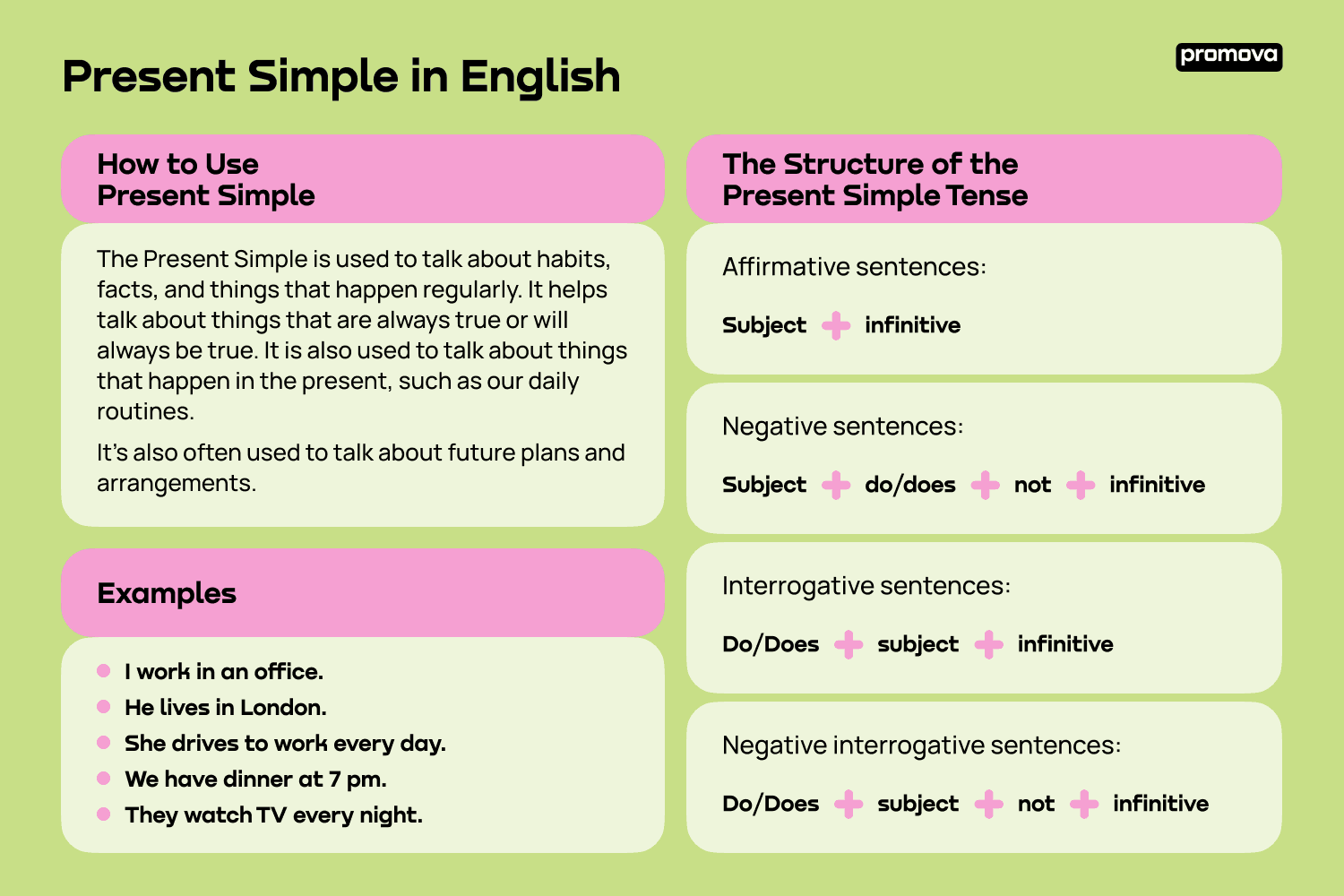Present Simple in English
Contents
In this reference, we will discuss everything you need to know about the Present Simple tense. We will look at what the Present Simple is, its 4 forms, the structure of the Present Simple tense, how to use it, examples, and common mistakes to avoid. Plus, we will also cover all the important grammar rules related to the Present Simple. Let's start learning!
What is the Present Simple in English?
The Present Simple is the first tense you should learn in the English language. It is used to talk about habits, facts, and things that happen regularly. The Present Simple is used to talk about things that are always true or will always be true. It is also used to talk about things that happen in the present, such as our daily routines.
The Present Simple is formed using the base form of the verb (also known as the infinitive form). The base form of the verb is usually the same as the infinitive form (e.g., "to eat" = "eat"). However, there are some exceptions, such as the verb "to be" (e.g., "am," "is," "are").
The 4 Forms of the Present Simple
The Present Simple has four forms - affirmative, negative, interrogative, and negative interrogative. The affirmative form is used to make positive statements. The negative form is used to make negative statements. The interrogative form is used to make questions. And the negative interrogative form is used to make negative questions.
The Structure of the Present Simple Tense
Here is the present simple grammar you need to know:
For affirmative sentences, the structure is:
Subject + verb (in the base form) + rest of the sentence
For negative sentences, the structure is:
Subject + do/does + not + verb (in the base form) + rest of the sentence
For interrogative sentences, the structure is:
Do/Does + subject + verb (in the base form) + rest of the sentence
For negative interrogative sentences, the structure is:
Do/Does + subject + not + verb (in the base form) + rest of the sentence
How to Use Present Simple
The Present Simple is used to talk about habits, facts, and things that happen regularly. It helps talk about things that are always true or will always be true. It is also used to talk about things that happen in the present, such as our daily routines.
It's also often used to talk about future plans and arrangements. For example, you can say "I am meeting my friends for lunch tomorrow" or "We are going to the beach this weekend." 
Positive Sentences
Positive sentences in the Present Simple are used to make statements about habits, facts, and things that happen regularly. The structure of positive sentences is:
Subject + verb (in the base form) + rest of the sentence
For example:
- She speaks English.
- They go to school every day.
- He loves to read books.
- I eat breakfast every morning.
Negative Sentences
Negative sentences in the Present Simple are used to make statements about things that do not happen regularly or are not always true. The structure of negative sentences is:
Subject + do/does + not + verb (in the base form) + rest of the sentence
For example:
- She does not speak French.
- They do not go to the cinema every week.
- He does not like to watch TV.
- I do not eat lunch at work.
Questions
Questions in the Present Simple are used to ask about habits, facts, and things that happen regularly. The structure of questions is:
Do/Does + subject + verb (in the base form) + rest of the sentence
For example:
- Does she speak Spanish?
- Do they go to the park on Sundays?
- Does he like to play video games?
- Do I need to bring my own costume?
1
More examples of Present Simple sentences
Here are some examples of Present Simple sentences:
- I work in an office.
- He lives in London.
- She drives to work every day.
- We have dinner at 7 pm.
- They watch TV every night.
- Do you like to go hiking?
- Does she take the bus to school?
- Do we need to bring snacks?
- Does he play tennis on Saturdays?
Common Mistakes
One of the most common mistakes when using the Present Simple is forgetting to use the verb in the base form. For example, when using the verb "to be, "many people make the mistake of using the wrong form of the verb, such as "am" instead of "is."
Another common mistake is forgetting to use the auxiliary "do" or "does" when making negative sentences or questions. For example, many learners make the mistake of saying "He not like to play video games" instead of "He does not like to play video games."
It is also important to remember to use the correct subject-verb agreement. For example, when using the verb "to be, "many people make the mistake of saying "I am" instead of "You are."
Summary
The Present Simple is the most used tense in the English language. It's formed using the base form of the verb, and it has four forms - the affirmative, negative, interrogative, and negative interrogative. The structure for each of these forms is very simple, and you should master it in no time!
We hope this reference has been helpful and that you'll easily start to apply it in your own speech!
Comments